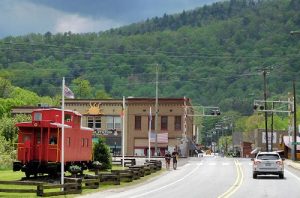WWI Internment Camp in Hot Springs, NC: “The German Village”

GERMANS ARE TRANSPORTED TO HOT SPRINGS HOTEL
The Mountain Park Hotel had been a thriving business until the outbreak of World War I when travel to the hotel slowed considerably. The owner Col. Rumbough negotiated a contract with the War Department to house Germans, most of whom were civilians and comprised of the crews of the German commercial ships which had taken cover in American ports when Great Britain declared war on Germany in 1914. Included in the group were members of a German orchestra as well as the crew of the world’s largest ship, the “Vaterland.” Because they were civilians, they could not be called “prisoners’ of-war” but were named “enemy aliens” by the Department of Immigration. Consequently, 2200 passengers, officers and crew members came by train to Hot Springs and spent the remaining 19 months of the war in the internment camp.

THE PRISONERS CREATE A VILLAGE
Officers were put into the hotel and the crew members in the barracks which were built on the hotel’s lawns. The grounds of this beautiful resort were changed into barracks, guard houses, and other facilities. Women were found rooms in town. The German men built a small village on the lawn of the hotel using scrap lumber, driftwood and flattened tin cans. The chapel was built of flattened Prince Albert Tobacco tins and was large enough to hold a few people for worship. Because there was no paint, they had to improvise so they mixed berry juices and colored clays to bring bright colors to their village. One of the detainees was a photographer, Adolph Thierbach, who chronicled his stay. Eventually he put all of his photographs into an album and captioned them. Photographs on this page are from his record of this.

WEEKLY CONCERTS BY THE GERMAN BAND
Because the town was so small, many friendships grew up between the Germans and the townspeople. Relatives of the internees were allowed to visit and many of the local people opened their homes. Guards took prisoners home for dinner. The Germans taught crafts to the townspeople (they were excellent dressmakers) and entertained them with band music. The brass band from the cruise ship practiced each day and gave concerts for the townspeople every Sunday afternoon.

THE LAST YEARS OF THE WAR
The 1916 flood damaged the Mountain Park Hotel and washed away the German Village, tents and barracks. The guests all escaped to higher ground. However, in 1918, the flu and typhoid epidemic proved fatal. Some of the Germans died and were buried in the Oddfellows Cemetery which is located just outside the town. Their bodies were later moved to Riverside Cemetery in Asheville. When the armistice was announced, the German band played all night. After the War ended, the Germans were transported to Fort Oglethope, Georgia. But, because of the warm friendships that had developed with the townspeople of Hot Springs, many of them came back after the war with their families.
The State Historic Marker on Bridge Street marks the location of the Camp: Hot Springs: the history of the resorts on this land
Information on the subject was provided by Jacqueline Burgin Painter, a historian who was born and raised in Hot Springs and has written The German Invasion of Western North Carolina: a Pictorial History. The photographs are taken from Adolph Thierbach’s record of his stay. The full photo album is available for viewing online.




